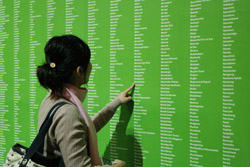

 Jonas Dahlberg, who studied architecture and then made the shift to art, devotes his work to capturing the essence of the psychological side of space. Making architectural models, Dahlberg films these constructed spaces so that they simulate their life-sized counterparts and then edits the films in a continuous loop. His models embody an imagination of hypothetical space, and at the same time become sculptures, which have a physical presence in and of themselves. From the point of view of a surveillance camera that seems to peep into these spaces, Dahlberg creates psychological tension from his repeated mastery of the space. His early works, Untitled (Horizontal Sliding), 2000 and Untitled (Vertical Sliding), 2001, utilize the camerawork seen in Stanley Kubrick’s The Shining, and capture rooms and corridors of the model that continue on into infinity. The works are tinged with a sense of discomfort and invisible fear that seems to pervade the uninhabited rooms decorated with florid simple wallpaper. In One-Way Street, 2002, the camera effortlessly slides amidst a barren street of a cityscape populated only with modernist buildings. The abstract fear that Dahlberg is able to stir up in his manmade urban space is amplified even further for the monotonous filmic sequences that he plays out in the realm of the dark.
Jonas Dahlberg, who studied architecture and then made the shift to art, devotes his work to capturing the essence of the psychological side of space. Making architectural models, Dahlberg films these constructed spaces so that they simulate their life-sized counterparts and then edits the films in a continuous loop. His models embody an imagination of hypothetical space, and at the same time become sculptures, which have a physical presence in and of themselves. From the point of view of a surveillance camera that seems to peep into these spaces, Dahlberg creates psychological tension from his repeated mastery of the space. His early works, Untitled (Horizontal Sliding), 2000 and Untitled (Vertical Sliding), 2001, utilize the camerawork seen in Stanley Kubrick’s The Shining, and capture rooms and corridors of the model that continue on into infinity. The works are tinged with a sense of discomfort and invisible fear that seems to pervade the uninhabited rooms decorated with florid simple wallpaper. In One-Way Street, 2002, the camera effortlessly slides amidst a barren street of a cityscape populated only with modernist buildings. The abstract fear that Dahlberg is able to stir up in his manmade urban space is amplified even further for the monotonous filmic sequences that he plays out in the realm of the dark.
Invisible Cities is based on extensive research and comprises text, a series of photographs and films. Dahlberg defines invisible cities as small towns that have all the things necessary to live a full life, yet the residents come up against the difficult situation of not being able to recognize their neighbors. He attempts to represent notions of invisibility and nothingness employing the concept of weightlessness. He films this by placing the models in a gyroscope, an action that causes a houseplant to seemingly float as it drifts throughout the room. Another film records an actual empty city as if the camera itself is floating above in ways no one has ever seen.